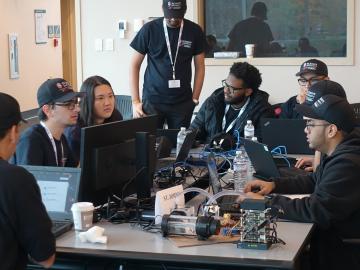
Filter News
Area of Research
- (-) Materials (35)
- (-) National Security (36)
- (-) Supercomputing (71)
- Advanced Manufacturing (6)
- Biology and Environment (45)
- Building Technologies (2)
- Computational Biology (1)
- Computational Engineering (2)
- Computer Science (9)
- Electricity and Smart Grid (3)
- Energy Science (110)
- Energy Sciences (1)
- Functional Materials for Energy (1)
- Fusion and Fission (7)
- Fusion Energy (1)
- Isotope Development and Production (1)
- Isotopes (27)
- Materials for Computing (7)
- Neutron Science (14)
- Nuclear Science and Technology (10)
- Quantum information Science (3)
- Sensors and Controls (1)
News Topics
- (-) Cybersecurity (23)
- (-) Grid (15)
- (-) Isotopes (14)
- (-) Machine Learning (24)
- (-) Space Exploration (5)
- (-) Summit (43)
- 3-D Printing/Advanced Manufacturing (28)
- Advanced Reactors (6)
- Artificial Intelligence (48)
- Big Data (25)
- Bioenergy (20)
- Biology (17)
- Biomedical (22)
- Biotechnology (3)
- Buildings (8)
- Chemical Sciences (32)
- Clean Water (3)
- Composites (9)
- Computer Science (108)
- Coronavirus (19)
- Critical Materials (15)
- Energy Storage (38)
- Environment (39)
- Exascale Computing (26)
- Frontier (32)
- Fusion (9)
- High-Performance Computing (47)
- Irradiation (1)
- ITER (1)
- Materials (80)
- Materials Science (83)
- Mathematics (2)
- Microscopy (29)
- Molten Salt (3)
- Nanotechnology (42)
- National Security (36)
- Neutron Science (43)
- Nuclear Energy (24)
- Partnerships (15)
- Physics (34)
- Polymers (18)
- Quantum Computing (21)
- Quantum Science (34)
- Security (15)
- Simulation (16)
- Software (1)
- Transportation (21)
Media Contacts

An international team of researchers has discovered the hydrogen atoms in a metal hydride material are much more tightly spaced than had been predicted for decades — a feature that could possibly facilitate superconductivity at or near room temperature and pressure.

To better determine the potential energy cost savings among connected homes, researchers at Oak Ridge National Laboratory developed a computer simulation to more accurately compare energy use on similar weather days.

Researchers across the scientific spectrum crave data, as it is essential to understanding the natural world and, by extension, accelerating scientific progress.

For nearly three decades, scientists and engineers across the globe have worked on the Square Kilometre Array (SKA), a project focused on designing and building the world’s largest radio telescope. Although the SKA will collect enormous amounts of precise astronomical data in record time, scientific breakthroughs will only be possible with systems able to efficiently process that data.

The U.S. Department of Energy’s Office of Science announced allocations of supercomputer access to 47 science projects for 2020.

Oak Ridge National Laboratory will give college students the chance to practice cybersecurity skills in a real-world setting as a host of the Department of Energy’s fifth collegiate CyberForce Competition on Nov. 16. The event brings together student teams from across the country to compete at 10 of DOE’s national laboratories.

Researchers at the Department of Energy’s Oak Ridge National Laboratory have received five 2019 R&D 100 Awards, increasing the lab’s total to 221 since the award’s inception in 1963.

The type of vehicle that will carry people to the Red Planet is shaping up to be “like a two-story house you’re trying to land on another planet.

Processes like manufacturing aircraft parts, analyzing data from doctors’ notes and identifying national security threats may seem unrelated, but at the U.S. Department of Energy’s Oak Ridge National Laboratory, artificial intelligence is improving all of these tasks.

Quanex Building Products has signed a non-exclusive agreement to license a method to produce insulating material from ORNL. The low-cost material can be used as an additive to increase thermal insulation performance and improve energy efficiency when applied to a variety of building products.


